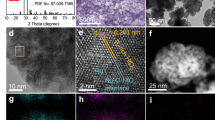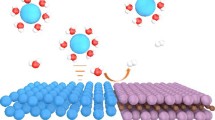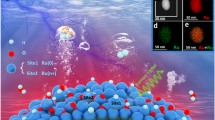Abstract
An effective strategy was proposed to control the formation of the interfacial bonding between Ru and molybdenum oxide support to stabilize the Ru atoms with the aim to enhance the hydrogen evolution reaction (HER) activity of the resultant catalysts in alkaline medium. The different interfacial chemical bonds, including Ru-O, Ru-O-Mo, and mixed Ru-Mo/Ru-O-Mo, were prepared using an induced activation strategy by controlling the composition of reducing agents in the calcination process. And the regulation mechanism of the interfacial chemical bonds in molybdenum oxide supported Ru catalysts for optimizing HER activity was investigated by density functional theory (DFT) and experimental studies. We found that a controlled interfacial chemical Ru-O-Mo bonding in Ru-MoO2/C manifests a 12-fold activity increase in catalyzing the hydrogen evolution reaction relative to the conventional metal/metal oxide catalyst (Ru-O-MoO2/C). In a bifunctional effect, the interfacial chemical Ru-O-Mo sites promoted the dissociation of water and the production of hydrogen intermediates that were then adsorbed on the nearby Ru surfaces and recombined into molecular hydrogen. As compared, the nearby Ru surfaces in Ru-Mo bonding have weak adsorption capacity for the generation of these hydrogen intermediates, resulting in a 5-fold increase HER activity for Ru-Mo-MoO2/C catalyst compared with Ru-O-MoO2/C.

Similar content being viewed by others
References
Sun, Y. J.; Liu, C.; Grauer, D. C.; Yano, J.; Long, J. R.; Yang, P. D.; Chang, C. J. Electrodeposited cobalt-sulfide catalyst for electrochemical and photoelectrochemical hydrogen generation from water. J. Am. Chem. Soc. 2013, 135, 17699–17702.
Jing, H. Y.; Zhu, P.; Zheng, X. B.; Zhang, Z. D.; Wang, D. S.; Li, Y. D. Theory-oriented screening and discovery of advanced energy transformation materials in electrocatalysis. Adv. Powder Mater. 2022, 1, 100013.
Zhu, P.; Xiong, X.; Wang, D. S. Regulations of active moiety in single atom catalysts for electrochemical hydrogen evolution reaction. Nano Res. 2022, 15, 5792–5815.
Kariuki, N.; Gurneau, J.; Mawdsley, J.; Wang, X.; Myers, D. Nanostructured alloy catalysts: Control of size, shape and composition. Microsc. Microanal. 2011, 17, 1696–1697.
Hutchings, G. J.; Kiely, C. J. Strategies for the synthesis of supported gold palladium nanoparticles with controlled morphology and composition. Acc. Chem. Res. 2013, 46, 1759–1772.
Dubouis, N.; Grimaud, A. The hydrogen evolution reaction: From material to interfacial descriptors. Chem. Sci. 2019, 10, 9165–9181.
Su, J. W.; Yang, Y.; Xia, G. L.; Chen, J. T.; Jiang, P.; Chen, Q. W. Ruthenium-cobalt nanoalloys encapsulated in nitrogen-doped graphene as active electrocatalysts for producing hydrogen in alkaline media. Nat. Commun. 2017, 8, 14969.
Mendoza-Pérez, R.; Guisbiers, G. Bimetallic Pt-Pd nano-catalyst: Size, shape and composition matter. Nanotechnology 2019, 30, 305702.
Chen, C. H.; Wu, D. Y.; Li, Z.; Zhang, R.; Kuai, C. G.; Zhao, X. R.; Dong, C. K.; Qiao, S. Z.; Liu, H.; Du, X. W. Ruthenium-based single-atom alloy with high electrocatalytic activity for hydrogen evolution. Adv. Energy Mater. 2019, 9, 1803913.
Wang, H. X.; Zhou, M.; Bo, X. J.; Guo, L. P. Rapid and facile laser-assistant preparation of Ru-ZIF-67-derived CoRu nanoalloy@N-doped graphene for electrocatalytic hydrogen evolution reaction at all pH values. Electrochim. Acta 2021, 382, 138337.
Zhang, L. J.; Jang, H.; Wang, Y.; Li, Z. J.; Zhang, W.; Kim, M. G.; Yang, D. J.; Liu, S. G.; Liu, X. E.; Cho, J. Exploring the dominant role of atomic- and nano-ruthenium as active sites for hydrogen evolution reaction in both acidic and alkaline media. Adv. Sci. 2021, 8, 2004516.
Jing, W.; Wei, Z. Z.; Mao, S. J.; Li, H. R.; Wang, Y. Highly uniform Ru nanoparticles over N-doped carbon: pH and temperature-universal hydrogen release from water reduction. Energ Environ. Sci. 2018, 11, 800–806.
Li, F.; Han, G. F.; Noh, H. J.; Ahmad, I.; Jeon, I. Y.; Baek, J. B. Mechanochemically assisted synthesis of a Ru catalyst for hydrogen evolution with performance superior to Pt in both acidic and alkaline media. Adv. Mater. 2018, 30, 1803676.
Liu, Y.; Li, X.; Zhang, Q. H.; Li, W. D.; Xie, Y.; Liu, H. Y.; Shang, L.; Liu, Z. Y.; Chen, Z. M.; Gu, L. et al. A general route to prepare low-ruthenium-content bimetallic electrocatalysts for pH-universal hydrogen evolution reaction by using carbon quantum dots. Angew. Chem. 2020, 132, 1735–1743.
Su, P. P.; Pei, W.; Wang, X. W.; Ma, Y. F.; Jiang, Q. K.; Liang, J.; Zhou, S.; Zhao, J. J.; Liu, J.; Lu, G. Q. Exceptional electrochemical her performance with enhanced electron transfer between Ru nanoparticles and single atoms dispersed on a carbon substrate. Angew. Chem., Int. Ed. 2021, 60, 16044–16050.
Liu, Y.; Li, X.; Zhang, Q. H.; Li, W. D.; Xie, Y.; Liu, H. Y.; Shang, L.; Liu, Z. Y.; Chen, Z. M.; Gu, L. et al. A general route to prepare low-ruthenium-content bimetallic electrocatalysts for pH-universal hydrogen evolution reaction by using carbon quantum dots. Angew. Chem., Int. Ed. 2020, 59, 1718–1726.
Xue, Y. R.; Shi, L.; Liu, X. R.; Fang, J. J.; Wang, X. D.; Setzler, B. P.; Zhu, W.; Yan, Y. S.; Zhuang, Z. B. A highly-active, stable and low-cost platinum-free anode catalyst based on RuNi for hydroxide exchange membrane fuel cells. Nat. Commun. 2020, 11, 5651.
Li, G. K.; Jang, H.; Liu, S. G.; Li, Z. J.; Kim, M. G.; Qin, Q.; Liu, X. E.; Cho J. The synergistic effect of Hf-O-Ru bonds and oxygen vacancies in Ru/HfO2 for enhanced hydrogen evolution. Nat. Commun. 2022, 13, 1270.
van Deelen, T. W.; Hernández Mejía, C.; de Jong, K. P. Control of metal-support interactions in heterogeneous catalysts to enhance activity and selectivity. Nat. Catal. 2019, 2, 955–970.
Yang, J. R.; Li, W. H.; Tan, S. D.; Xu, K. N.; Wang, Y.; Wang, D. S.; Li, Y. D. The electronic metal-support interaction directing the design of single atomic site catalysts: Achieving high efficiency towards hydrogen evolution. Angew. Chem., Int. Ed. 2021, 60, 19085–19091.
Li, R. Z.; Wang, D. S. Understanding the structure—performance relationship of active sites at atomic scale. Nano Res. 2022, 15, 6888–6923.
Zheng, X. B.; Li, B. B.; Wang, Q. S.; Wang, D. S.; Li, Y. D. Emerging low-nuclearity supported metal catalysts with atomic level precision for efficient heterogeneous catalysis. Nano Res. 2022, 15, 7806–7839.
Nong, S. Y.; Dong, W. J.; Yin, J. W.; Dong, B. W.; Lu, Y.; Yuan, X. T.; Wang, X.; Bu, K. J.; Chen, M. Y.; Jiang, S. D. et al. Well-dispersed ruthenium in mesoporous crystal TiO2 as an advanced electrocatalyst for hydrogen evolution reaction. J. Am. Chem. Soc. 2018, 140, 5719–5727.
Liu, Z. Y.; Zhang, F.; Rui, N.; Li, X.; Lin, L. L.; Betancourt, L. E.; Su, D.; Xu, W. Q.; Cen, J. J.; Attenkofer, K. Highly active ceria-supported Ru catalyst for the dry reforming of methane: In situ identification of Ruδ;+-Ce3+ interactions for enhanced conversion. ACS Catal. 2019, 9, 3349–3359.
Ftouni, J.; Muñoz-Murillo, A.; Goryachev, A.; Hofmann, J. P.; Hensen, E. J. M.; Lu, L.; Kiely, C. J.; Bruijnincx, P. C. A.; Weckhuysen, B. M. ZrO2 is preferred over TiO2 as support for the Ru-catalyzed hydrogenation of levulinic acid to γ-valerolactone. ACS Catal. 2016, 6, 5462–5472.
Abdel-Mageed, A. M.; Widmann, D.; Olesen, S. E.; Chorkendorff, I.; Behm, R. J. Selective CO methanation on highly active Ru/TiO2 catalysts: Identifying the physical origin of the observed activation/deactivation and loss in selectivity. ACS Catal. 2018, 8, 5399–5414.
Jiang, J. X.; Tao, S. C.; He, Q.; Wang, J.; Zhou, Y. Y.; Xie, Z. Y.; Ding, W.; Wei, Z. D. Interphase-oxidized ruthenium metal with half-filled d-orbitals for hydrogen oxidation in an alkaline solution. J. Mater. Chem. A 2020, 8, 10168–10174.
Zhou, Y. Y.; Xie, Z. Y.; Jiang, J. X.; Wang, J.; Song, X. Y.; He, Q.; Ding, W.; Wei, Z. D. Lattice-confined Ru clusters with high CO tolerance and activity for the hydrogen oxidation reaction. Nat. Catal. 2020, 3, 454–462.
Zhang, N. Q.; Li, L. C.; Guo, Y. Z.; He, J. D.; Wu, R.; Song, L. Y.; Zhang, G. Z.; Zhao, J. S.; Wang, D. S.; He, H. A MnO2-based catalyst with H2O resistance for NH3-SCR: Study of catalytic activity and reactants-H2O competitive adsorption. Appl. Catal. B 2020, 270, 118860.
Du, H. M.; Ding, F. F.; Zhao, J. S.; Zhang, X. X.; Li, Y. W.; Zhang, Y.; Li, J.; Yang, X. F.; Li, K.; Yang, Y. Q. Core-shell structured Ni3S2@VO2 nanorods grown on nickel foam as battery-type materials for supercapacitors. Appl. Surf. Sci. 2020, 508, 144876.
Zhang, N. Q.; Li, L. C.; Chu, Y.; Zheng, L. R.; Sun, S. R.; Zhang, G. Z.; He, H.; Zhao, J. S. High Pt utilization efficiency of electrocatalysts for oxygen reduction reaction in alkaline media. Catal. Today 2019, 332, 101–108.
Liu, Y. Y.; Xie, Y.; Ling, Y.; Jiao, J. L.; Li, X.; Zhao, J. S. Facile construction of a molybdenum disulphide/zinc oxide nanosheet hybrid for an advanced photocatalyst. J. Alloys Compd. 2019, 778, 761–767.
Zeng, D. D.; Yang, L. M.; Zhou, P. P.; Hu, D. S.; Xie, Y.; Li, S. Q.; Jiang, L. S.; Ling, Y.; Zhao, J. S. Au-Cu alloys deposited on titanium dioxide nanosheets for efficient photocatalytic hydrogen evolution. Int. J. Hydrogen Energy 2018, 43, 15155–15163.
Xia, Q.; Zhao, H. L.; Du, Z. H.; Wang, J.; Zhang, T. H.; Wang, J.; Lv, P. P. Synthesis and electrochemical properties of MoO3/C composite as anode material for lithium-ion batteries. J. Power Sources 2013, 226, 107–111.
Han, W.; Yuan, P.; Fan, Y.; Shi, G.; Liu, H. Y.; Bai, D. J.; Bao, X. J. Preparation of supported hydrodesulfurization catalysts with enhanced performance using Mo-based inorganic—organic hybrid nanocrystals as a superior precursor. J. Mater. Chem. 2012, 22, 25340–25353.
Jin, Y. S.; Wang, H. T.; Li, J. J.; Yue, X.; Han, Y. J.; Shen, P. K.; Cui, Y. Porous MoO2 nanosheets as non-noble bifunctional electrocatalysts for overall water splitting. Adv. Mater. 2016, 28, 3785–3790.
Li, C.; Jang, H.; Kim, M. G.; Hou, L. Q.; Liu, X. E.; Cho, J. Ruincorporated oxygen-vacancy-enriched MoO2 electrocatalysts for hydrogen evolution reaction. Appl. Catal. B: Environ. 2022, 307, 121204.
Zeng, H. B.; Chen, S. Q.; Jin, Y. Q.; Li, J. W.; Song, J. D.; Le, Z. C.; Liang, G. F.; Zhang, H.; Xie, F. Y.; Chen, J. et al. Electron density modulation of metallic MoO2 by Ni doping to produce excellent hydrogen evolution and oxidation activities in acid. ACS Energy Lett. 2020, 5, 1908–1915.
Li, H. J. W.; Liu, K.; Fu, J. W.; Chen, K. J.; Yang, K. X.; Lin, Y. Y.; Yang, B. P.; Wang, Q. Y.; Pan, H.; Cai, Z. J. et al. Paired Ru-O-Mo ensemble for efficient and stable alkaline hydrogen evolution reaction. Nano Energy 2021, 82, 105767.
Li, Y. Z.; Abbott, J.; Sun, Y. C.; Sun, J. M.; Du, Y. C.; Han, X. J.; Wu, G.; Xu, P. Ru nanoassembly catalysts for hydrogen evolution and oxidation reactions in electrolytes at various pH values. Appl. Catal. B: Environ. 2019, 258, 117952.
Ha, D. H.; Han, B. H.; Risch, M.; Giordano, L.; Yao, K. P. C.; Karayaylali, P.; Shao-Horn, Y. Activity and stability of cobalt phosphides for hydrogen evolution upon water splitting. Nano Energy 2016, 29, 37–45.
Zhou, D.; He, L. B.; Zhu, W. X.; Hou, X. D.; Wang, K. Y.; Du, G.; Zheng, C. B.; Sun, X. P.; Asiri, A. M. Interconnected urchin-like cobalt phosphide microspheres film for highly efficient electrochemical hydrogen evolution in both acidic and basic media. J. Mater. Chem. A 2016, 4, 10114–10117.
Wang, X. S.; Zheng, Y.; Sheng, W. C.; Xu, Z. J.; Jaroniec, M.; Qiao, S. Z. Strategies for design of electrocatalysts for hydrogen evolution under alkaline conditions. Mater. Today 2020, 36, 125–138.
Tang, C.; Zhang, R.; Lu, W. B.; Wang, Z.; Liu, D. N.; Hao, S.; Du, G.; Asiri, A. M.; Sun, X. P. Energy-saving electrolytic hydrogen generation: Ni2P nanoarray as a high-performance non-noble-metal electrocatalyst. Angew. Chem. 2017, 129, 860–864.
Lu, X. Y.; Zhao, C. Electrodeposition of hierarchically structured three-dimensional nickel-iron electrodes for efficient oxygen evolution at high current densities. Nat. Commun. 2015, 6, 6616.
Gao, Q. S.; Zhang, W. B.; Shi, Z. P.; Yang, L. C.; Tang, Y. Structural design and electronic modulation of transition-metal-carbide electrocatalysts toward efficient hydrogen evolution. Adv. Mater. 2019, 31, 1802880.
Jiang, K. X.; Zhu, L.; Wang, Z. H.; Liu, K.; Li, H. M.; Hu, J. H.; Pan, H.; Fu, J. W.; Zhang, N.; Qiu, X. Q. et al. Plasma-treatment induced H2O dissociation for the enhancement of photocatalytic CO2 reduction to CH4 over graphitic carbon nitride. Appl. Surf. Sci. 2020, 508, 145173.
Jiang, Y. B.; Sun, Z. Z.; Tang, C.; Zhou, Y. X.; Zeng, L.; Huang, L. M. Enhancement of photocatalytic hydrogen evolution activity of porous oxygen doped g-C3N4 with nitrogen defects induced by changing electron transition. Appl. Catal. B: Environ. 2019, 240, 30–38.
Chen, W. B.; Maugé, F.; van Gestel, J.; Nie, H.; Li, D. D.; Long, X. Y. Effect of modification of the alumina acidity on the properties of supported Mo and CoMo sulfide catalysts. J. Catal. 2013, 304, 47–62.
Seh, Z. W.; Kibsgaard, J.; Dickens, C. F.; Chorkendorff, I. B.; Nørskov, J. K.; Jaramillo, T. F. Combining theory and experiment in electrocatalysis: Insights into materials design. Science 2017, 355, eaad4998.
Fu, L. H.; Li, Y. B.; Yao, N.; Yang, F. L.; Cheng, G. Z.; Luo, W. IrMo nanocatalysts for efficient alkaline hydrogen electrocatalysis. ACS Catal. 2020, 10, 7322–7327.
Acknowledgements
The authors gratefully acknowledge financial supports by the National Natural Science Foundation of China (No. 21978126).
Author information
Authors and Affiliations
Corresponding authors
Electronic Supplementary Material
12274_2022_5013_MOESM1_ESM.pdf
An insight into the enhanced mechanism of Ru-MoO2 interfacial chemical bonding for hydrogen evolution reaction in alkaline media
Rights and permissions
About this article
Cite this article
Yuan, Y., Han, W., Zhang, C. et al. An insight into the enhanced mechanism of Ru-MoO2 interfacial chemical bonding for hydrogen evolution reaction in alkaline media. Nano Res. 16, 2230–2235 (2023). https://doi.org/10.1007/s12274-022-5013-z
Received:
Revised:
Accepted:
Published:
Issue Date:
DOI: https://doi.org/10.1007/s12274-022-5013-z




